

The Triumph Stag was a popular British car sold between 1970 and 1978 by Triumph of Coventry; the styling was from the studio of Giovanni Michelotti from Italy.
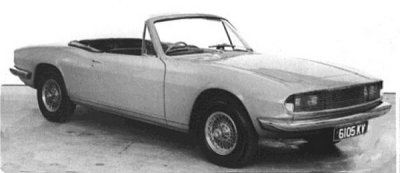 |
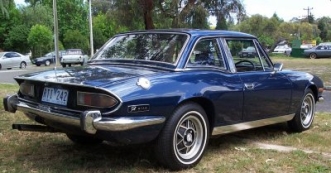 |
| Michelotti's original design based on the Mk I Sedan | Stag with hard top fitted The style was carried over to the Mk II Sedan |
Design and Styling
Seen as a Grand Tourer, the Triumph Stag was designed to be a gentleman's sports tourer, to compete with the Mercedes-Benz SL class. Stags were four-seater convertibles, but to meet new American rollover standards at the time, the Stag was fitted with a B-pillar "roll bar" connected to the windscreen frame by a T-bar. A hardtop (removable) was a factory option for early Stags, and was later supplied as standard, making the car a 3-in-1 Hard top, Soft top or no top at all.
The car started as a 1963-4 Triumph 2000 pre-production saloon which was orginally styled by Michelotti. Harry Webster, Director of Engineering at Triumph from the mid to late 1960s, loaned him the car to redesign as a two-door convertible tourer. The agreement was that if Harry liked the design, Triumph may use the prototype as the base of a new model. Harry was reported as to have liked the new design and rushed the prototype back to the UK.
The end result, a two door DHC (drop head convertible) shared the same floor plan as the MkI 2000 retaining its suspension and drive train. Triumph liked the Michelotti design so much that they carried the body styling lines of the Stag into the forthcoming Mk II 2000/2500 series of saloon and estate model lines from the early 1970s.
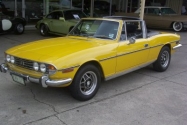 |
| Stag showing "T" Bar from "B" Pillar to windscreen |
Engineering
It has been said that internal politics meant that Triumph intended, but were unable, to use the proven but old technology General Motors (Buick) designed aluminium V8 engine as used by Rover. Rover, also owned at the time by British Leyland, could not supply the numbers of aluminium V8 engines to match the production of the Stag and the Rover 3500, Harry Webster had already started developing and testing of a new all Triumph designed overhead cam 2.5 litre fuel injected V8 for use in the Stag, large saloons and estate cars. The vision was to allow Triumph to compete in the new and exciting V8 market. Spen King replaced Harry Webster in 1968, and it was under Spen's direction that the Triumph 2.5 V8 was enlarged to 2997 cc (3.0 litre) to increase torque. The troublesome fuel injection was shelved in favour of dual Zenith-Stromberg 175 CDSE carburetors as these met emission standards for the target market - USA.
The Triumph Slant-4 engine shared the same basic design as the Triumph V8, consisting of a single overhead cam cast iron block with aluminium heads. However the cylinder heads of the two engines do not share the same footprint on their respective engine blocks. This same engine manufactured by StanPart was initially used in the Saab 99. Using a gear driven water pump, the Slant 4 could be easily installed in a front wheel drive car. This same water pump design was used in the Stag V8.
As in the Triumph 2000 model line, monocoque construction was employed, as was fully independent suspension MacPherson struts in front, semi-trailing arms at the rear. Braking was by front disc and rear drum brakes, while steering was power-assisted rack and pinion.
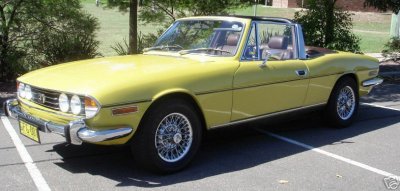 |
| Stag with Wire Wheels |
Production
The car was launched in 1970, to a somewhat weak welcome at the various international auto shows, which soon turned sour after delivery to the market with reports of engine problems. Some of these were due to the poor build quality epidemic which had set into the British motor industry in the late 60�s and early 70�s, whilst the car was of sound construction, and was on its way to being a world beater, the poor design of the engine, failed to make the car what it was destined to be, many feel poor design of the power plant was the demise of the car.
These include:
British Leyland never provided sufficient budget to correct the few design issues of the Triumph 3.0 litre V8. The obvious choice for many owners was to convert the car replacing the Triumph V8 with a Rover V8, Ford Capri 2.8 V6, Buick 231 V6, and in some cases the 2500 Triumph 6-cylinder engine. These conversions lower the price of the car, than that of a genuine Stag V8-engined car.
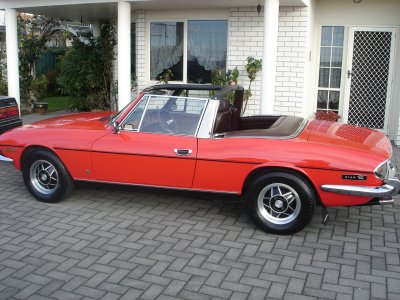 |
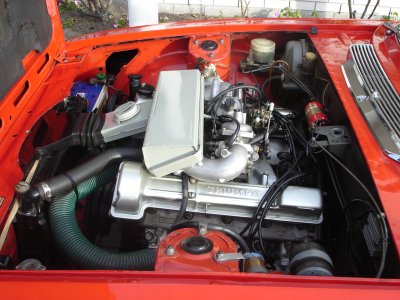 |
| Peter K's immaculate Stag showing Triumph OHC V8 Engine | |
Only 25,877 cars were produced between 1970 and 1977. Of these, 6,780 were exported, only 2,871 went to the United States. Most cars were fitted with a Borg-Warner 3-speed automatic transmission. The manual option was the 4 speed with overdrive this gearbox was first seen in the Tr2, the box was modified and improved for use in the TR4 trough to TR6 including the Sedan 2500 range. First gear ratio was raised and needle roller bearings were used in place of the bronze bushings on the layshaft. The overdrive option is highly desirable as the engine RPM is excessive without it.
Other than the choice of transmissions there were very few factory installed options. Electric windows, power steering and power assisted brakes were standard. Options included air conditioning, chrome wire wheels, luggage rack, Koni shock absorbers, and a range of aftermarket products, most of which were dealer installed as optional accessories.